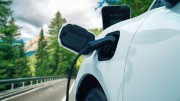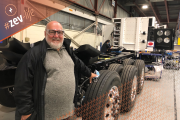Canada’s electric vehicle sector is about to enter a period of explosive growth. Domestic consumer purchases of electric cars continue to rise (zero-emission vehicle registrations were 11.3% as of the first quarter in 2024 compared to 8.6% in the first quarter of 2023). While growth in adoption of zero-emission commercial vehicles trails that of passenger cars, market share is increasing, nudging up from 1.7% in 2020 to 3.7% as of 2021.
The lag we see in uptake of electric medium- and heavy-duty vehicles (MHDVs) relative to the light-duty sector is the result of many factors. One of the most significant is that the MHDV ecosystem has overlooked small fleet operators. For the most part, only large, well-resourced, fleet operators have the financial means to acquire zero-emission vehicles, install charging infrastructure and secure favourable financing opportunities. As long as this is the case, and small fleet owners and operators remain sidelined, Canada will fall short of achieving a fully sustainable road transport system.
To address the disparities among owners and operators of commercial vehicles and support an equitable transition, the Pembina Institute launched an awareness-raising project to surface the unique needs of women- and minority-owned small fleet operations.
Over the course of the first stage of our project, we crystalized the impediments that prevent owners from investing in zero-emission MHDVs. As phase one winds down, we can provide a summary of findings to date. In the second phase of the project, we will develop resources that participants flagged as critical to making informed decisions on vehicle purchases.
Community outreach
Fleet operators who participated in our project either owned their own freight delivery company or worked on contract for a delivery service provider. We also interviewed business owners who use delivery vehicles to support their services, such as a catering operation or florist shop. Participants had to meet specific criteria:
- Own and/or operate between one and 20 trucks or vans for business purposes
- Identify as either or both:
- Women (cisgender or transgender) or gender-diverse
- Visible, ethnic and/or cultural minority
We spoke with owners and drivers based in Alberta, British Columbia, Ontario and Saskatchewan. Most owned a single truck or van and travelled between 260 and 450 kilometres daily. Many of the participants operated Class 2b vehicles, including step vans, cube vans and full-size pickup trucks such as a Ford Transit or Dodge Ram 3500 ProMaster. Less common were Class 4, 5 or 6 vehicles. Only a few participants drove Class 7 or 8 MHDVs. Most interviewees used their truck or van to make last-mile deliveries.
The top six challenges
Fleet owners and operators across the sector face numerous obstacles in the transition to zero-emission MHDVs. Generally, these include high upfront costs, uncertainty about policy and regulatory requirements, unfamiliarity with the new technology, limited model availability, and insufficient charging and refuelling infrastructure. Ongoing research shows that for women- and minority-owned small fleets, these hurdles are especially pronounced.
We identified the following six obstacles that owners of small fleets face in replacing a fossil-fuelled vehicle with an electric one:
- The majority (52%) of participants stated that financial concerns were the number one obstacle to investing in an electric commercial vehicle. Owners of small fleets rarely have the capital or even access to credit that investing in one or more zero-emission trucks requires. These businesses operate on thin margins and generally don’t undertake transactions on a scale that facilitates favourable lending rates. Consequently, the high upfront cost of an electric commercial vehicle can be prohibitive for many women- and minority-owned fleets, and there is little capacity to assume the risks and uncertainties associated with switching to electric models.
- Unlike bigger players, small operators seldom have the financial means to install charging equipment; in fact, they may not have access to a yard that can accommodate installation. Owners of small fleets often rent rather than own property, in which case fleet owners must consult with the property manager, potentially complicating who has ownership and financial responsibility for installing chargers.
- Many owners of small fleets buy used vehicles, and the secondary market for zero-emission MHDVs is not yet established.
- Small-scale owners take on greater risk should they invest in electric MHDVs without having back-up vehicles. Concerns were raised about opportunity costs due to the maintenance of zero-emission trucks, specifically a widely held worry that taking vehicles off the road to be serviced for long periods of time could jeopardize a business.
- Participants expressed a high degree of uncertainty about the new technology. Many fleet owners are still trying to assess vehicle range, as well as how and where to access charging and refuelling stations.
- Outreach and marketing efforts are largely based on the assumption that fleet operators own a depot, use telematics and have a green freight strategy. Minimal effort has been made to incorporate images and case studies of owners and operators from diverse communities into material about carbon-neutral commercial fleets nor do pilot projects include small-scale businesses. Interviewees also reported that they had never seen or driven a zero-emission MHDV.
Conclusion
Our findings confirm what other researchers have concluded. Owners of small fleets must overcome considerable financial and institutional obstacles before moving away from fossil fuel-powered vehicles. This demographic experiences far greater difficulty relative to owners of larger fleets in accessing information to enable a zero-emission transition; they struggle to find resources about electric commercial vehicles. Manufacturers and retailers, as well as other entities that could be a source of information, tend to bypass small-scale operators in favour of much bigger delivery services. In most instances, owners and operators running small shops are unaware of the benefits of electrification and, relatedly, are unsure that electric models will meet their business needs.
Nevertheless, the barriers to adoption of zero-emission commercial vehicles are far from insurmountable. Early and meaningful engagement with women- and minority owners will create opportunities for this demographic to enter the market as fleet electrification increases in scale and pace.







